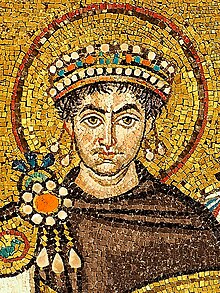The Kiss (Klimt)

The Kiss or The Lovers is a painting by Gustav Klimt. It was the last painting in Klimt's Gold Period. He painted it in 1907 or 1908.[1] It is one of the most famous paintings in the world.[2]
The Österreichische Galerie Belvedere museum, in the Belvedere palace, in Vienna, Austria is exhibiting the painting.
Painting[change | change source]

The painting shows a couple embracing each other with gold leaf on canvas. The man is kissing the woman, who has green hair. Klimt has said he had obsession for the woman with redheads, and it was reflected in the woman in his painting.
The man and woman are on a flowery grassland. According to the psychoanalytical and biological distinction, Klimt expressed them in different ways. The man wearing a robe with black, white and gray rectangles is described in a rough way, while the woman is expressed with the smooth figures such as a circle, a curve, and flowery patterns. Her hair is also combined with flowers; it looks like she is surrounded with flowers. On the contrary, the part outside the couple in the painting is filled with flat patterning which has small gleaming dots.
"The Kiss" represents fin-de-siècle spirit because it shows a decadence through opulent and sybaritic images. Also, the painting has some styles recalling the arts of other period. Of them, by using gold leaf, the painting reflects medieval "gold-ground" paintings and earlier mosaics, and the spiral patterns in the clothes recall Bronze Age art.
In the Kiss, Klimt portrays woman as the femme fatale who is a beautiful woman attracting men sexually but brings them unhappiness. It is said that the woman modeled for the painting, however, his life companion Emilie Flöge,who participated as the Viennese bohemian (Bohemianism) and fin-de-siecle circles like Klimt.
The painting is 72 inches high and 72 inches wide (180 cm x 180 cm). It is decorated with gold leaf. At the time, people thought the panting was too sexy, even though both people are wearing clothes.[1][3]
The city of Vienna bought the painting from Klimt before he finished it. It cost 25,000 crowns.[3]
Influences[change | change source]

Klimt was a Symbolist artist[4] and this painting was part of his Golden Period. Klimt went to the Basilica of San Vitale in Ravenna, where he saw Byzantine art, which also uses gold. Also, his father and brother were metalworkers. This is another reason why he liked to use gold leaf in paintings like The Kiss.[1] Japanese prints also affected the way Klimt made the painting.[3]
Legacy[change | change source]
In 2003, Austria struck a coin with The Kiss on one side and Klimt's face on the other.[1]
As of the 21st century, the painting is in the Belvedere Gallery.[1] Hundreds of thousands of people visit it each year.[2]
References[change | change source]
- ↑ 1.0 1.1 1.2 1.3 1.4 "The Kiss, 1907 by Gustav Klimt". Gustav Klimt.com. Retrieved May 23, 2021.
- ↑ 2.0 2.1 "The legacy of Gustav Klimt and his enduring 'Kiss'". CNN. February 28, 2018. Retrieved May 23, 2021.
- ↑ 3.0 3.1 3.2 Katie White (March 3, 2021). "Klimt's Glittering Ode to Love Scandalized Turn-of-the-Century Audiences. Here Are 3 Things You May Not Know About 'The Kiss'". Artnet. Retrieved May 23, 2021.
- ↑ Kelly Richman-Abdou (September 16, 2018). "The Splendid History of Gustav Klimt's Glistening "Golden Phase"". My Modern Met. Retrieved May 22, 2021.
